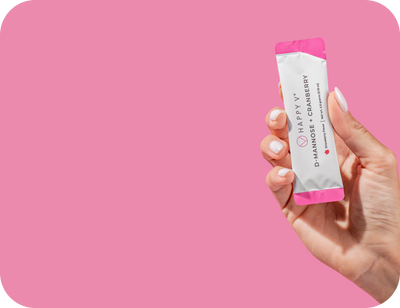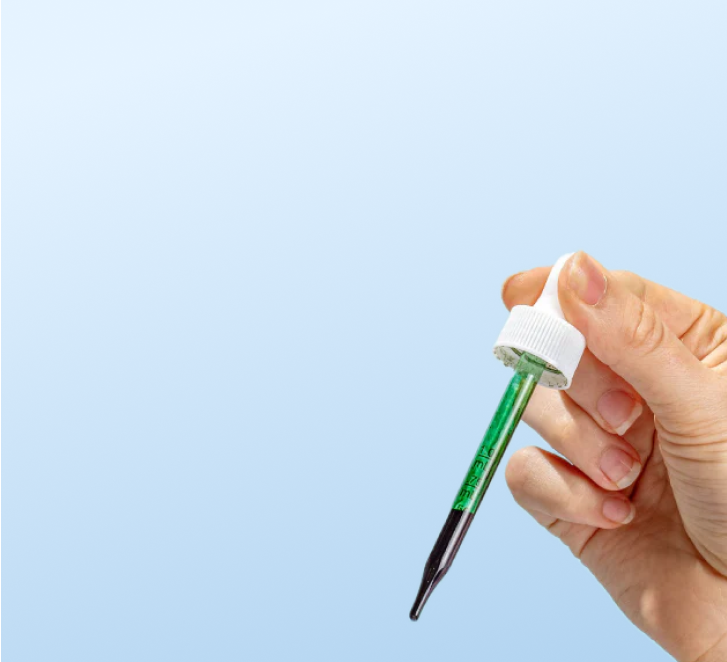- Fact Checked
- October 22, 2025
- 17 min read
Gardnerella vaginalis: Causes, Symptoms, and What to Do About It
Table of Contents
Table of Contents
If your vaginal microbiome had a troublemaker, Gardnerella vaginalis might top the list1. This common gram-positive, anaerobic bacterium is often present in healthy vaginal flora (albeit in small amounts). But under certain conditions, it can multiply fast and trigger bacterial vaginosis (BV), the most common vaginal infection among people of reproductive age2.
In this guide, we’ll unpack everything you need to know about Gardnerella vaginalis: what it is, why it overgrows, how to test for it, and the best ways to bring your vaginal flora back into balance, whether through medical treatment or natural support. Because when your vaginal pH is out of sync, it’s not just your microbiome that feels off, but your whole vibe.
This post is for informational purposes only and does not constitute medical advice. See full disclaimer below.
Definition and Role of Gardnerella vaginalis
You’ve probably heard Gardnerella vaginalis described as the bacterium behind bacterial vaginosis (BV)3. And while that’s not wrong, it’s only part of the story.
In reality, G. vaginalis is part of a normal vaginal flora4. In fact, most women of reproductive age (55%) have it, whether or not they have symptoms or an infection. In small amounts, it can actually support a healthy environment by helping maintain the vagina’s slightly acidic pH (between 3.8 and 4.5), which discourages harmful bacteria from taking hold5.
So, is Gardnerella good or bad? It depends on the balance.
When protective bacteria like Lactobacillus are dominant, G. vaginalis usually keeps a low profile. But when that balance shifts due to hormonal changes, sex, stress, or douching, G. vaginalis can multiply. That’s when it becomes more of a problem, often leading to BV6.
Scientists have also discovered that G. vaginalis isn’t just one type of bacteria. There are several closely related species, including:
- G. leopoldii
-
G. piotii
- G. swidsinskii
And each of these species behaves differently in the vagina. This explains why some people with Gardnerella overgrowth may have symptoms and others don’t. It may come down to which species of Gardnerella they are dealing with, but more research is needed to understand each of these species and how they affect vaginal health.
One of G. vaginalis’s most interesting features is its ability to form biofilms, or thin layers of bacteria that stick to the vaginal wall7. This is a smart survival strategy that helps it resist antibiotics and partner up with other bacteria like Mobiluncus or Prevotella.
In a healthy vaginal ecosystem, this feature helps it coexist. But in an imbalanced one, biofilms can make infections harder to treat and more likely to come back.
Because of these patterns, Gardnerella is often seen as an "indicator species" for vaginal dysbiosis8. In fact, a microbiome dominated by Gardnerella (called Community State Type IV) has been linked to recurring BV and increased infection risk, but not always symptoms.
Some people with a Gardnerella-dominant microbiome feel totally fine, while others struggle with chronic irritation or discharge.
Lastly, it’s worth noting that older research used to point the finger at G. vaginalis as the sole cause of BV, but we now know that BV is a team effort—a complex shift involving multiple bacteria, not just one. Gardnerella may lead the charge, but it’s not acting alone.
Causes and Risk Factors
So what causes G. vaginalis to go rogue? A lot, actually. Which is probably why bacterial vaginosis isn’t just common, but the most common vaginal infection, affecting 21 million women every year… in the United States alone.
When it comes to flora imbalances, there are several biological, lifestyle, and environmental factors at play.
Biological Factors
The most common biological factors behind vaginal dysbiosis include:
- Hormonal fluctuations: Menstrual cycles, pregnancy, and menopause can shift your vaginal pH and microbiome composition9.
- Pregnancy: Increases in vaginal glycogen can feed certain anaerobic bacteria.
- Menopause: Estrogen decline often results in a less acidic vaginal environment.
- Vaginal pH levels: A healthy pH is acidic (~3.8–4.5). A rise above this creates the perfect storm for overgrowth.
Lifestyle & Environmental Factors
Your vagina doesn’t exist in a vacuum. It’s highly affected by everyday factors, including:
- Sexual intercourse: Semen has a higher pH and can temporarily disrupt vaginal acidity10.
- New or multiple sex partners: Exposure to different penile microbiomes can introduce new microbes and elevate risk.
- Smoking cigarettes: Smoking alters estrogen levels and impairs immune defense in the vaginal epithelium.
- Douching and vaginal deodorants: These interfere with the self-cleaning mechanism of the vagina and disrupt the flora11.
- Birth control: Hormonal contraceptives may affect vaginal pH and microbiota balance12.
- Chronic stress: Cortisol dysregulation can impair immune function, allowing opportunistic pathogens to thrive.
Bottom line: G. vaginalis thrives when your natural defenses are down. Understanding your risk factors can help you make informed choices.
Symptoms and Health Implications
Not everyone with G. vaginalis overgrowth experiences symptoms, but when they do, they’re often associated with symptoms of BV. These include:
- Abnormal vaginal discharge that’s thin, watery, or grayish-white
- Strong, fishy odor, especially after sex13
- Vaginal itching or irritation
- Increased discharge without visible infection
While BV is super common and highly treatable, it should never be ignored. If left unmanaged, G. vaginalis overgrowth can lead to more serious complications, including:
- Pelvic inflammatory disease14
- Recurrent symptoms
- Adverse pregnancy outcomes, including preterm birth
- Increased risk of STIs, such as gonorrhea and chlamydia
- Fertility issues due to chronic inflammation or untreated infections
Diagnosis and Testing for Gardnerella vaginalis
Getting clarity about what’s happening “down there” can feel overwhelming, but understanding the testing process for Gardnerella vaginalis puts you in control of your health. More than that, it’s pretty simple, with the option to get tested at your doctor's or through an at-home kit.
When Should You Consider Testing?
You might want to get tested for G. vaginalis or bacterial vaginosis (BV) if:
- You notice unusual vaginal discharge (thin, watery, or grayish-white)
- There’s a persistent fishy odor, especially after sex
- You’re experiencing vaginal itching or irritation
- You have recurring BV or urinary tract infections (UTIs)
- You’re pregnant or planning a pregnancy and want to optimize your vaginal health
- A recent microbiome or STI test flagged Gardnerella, even if you feel fine
Remember: G. vaginalis is often present in healthy people. Testing for G. vaginalis is often not necessary unless you experience unusual or uncomfortable symptoms.
However, if you have a history of recurrent urinary tract infections, are pregnant, or are at increased risk for sexually transmitted infections, your healthcare provider may recommend testing to help prevent related complications.
Testing may also be recommended if you are pregnant or have a history of recurrent BV or UTIs, since Gardnerella overgrowth can increase the risk of complications like preterm birth or infection flare-ups.
Types of Tests: What to Expect
In-Clinic Testing
Seeing a healthcare provider is the gold standard for diagnosis, especially if you have moderate to severe symptoms or are pregnant.
Symptoms of Gardnerella vaginalis overgrowth and BV can mimic symptoms of other infections, including sexually transmitted infections (STIs), which is why accurate diagnosis is so important15.
Here’s what might happen during your visit:
-
Physical Exam & Symptom Review: Your provider will ask about your symptoms and may perform a pelvic exam.
-
Vaginal Swab: A sample is collected from your vaginal wall to look for signs of infection.
-
Amsel Criteria: This classic method checks for several BV indicators:
- Vaginal pH higher than 4.516
- Fishy odor when a chemical is added (the “whiff test”)
- Thin, homogeneous discharge
- “Clue cells” (vaginal cells coated with bacteria) seen under a microscope
- Diagnosis usually requires at least three of these four criteria.
- Vaginal pH higher than 4.516
-
Gram Stain & Nugent Score: The vaginal swab is stained and examined under a microscope. A scoring system (0–10) rates the balance of bacteria:
-
0–3: Normal (healthy)17
-
4–6: Intermediate
-
7–10: BV likely (high Gardnerella and other anaerobes)
-
0–3: Normal (healthy)17
-
Molecular Tests (PCR/DNA Probes): These tests detect the genetic material of G. vaginalis and other microbes. They’re very sensitive and can identify even small amounts of bacteria.
At-Home Testing
At-home kits are a convenient way to monitor your vaginal health, especially if you have mild symptoms or want to track changes over time.
These at-home kits come in 2 main forms:
-
Vaginal pH Strips: These test the acidity of your vaginal fluid. A pH above 4.5 can be an early sign of BV, but pH alone isn’t enough for a full diagnosis18.
-
Vaginal Microbiome Panels: Advanced tests (like those from Evvy or Juno) use DNA sequencing to identify hundreds of bacteria and fungi, including Gardnerella. These are especially helpful if you have unexplained or recurring symptoms.
Interpreting Your Results
Understanding your test results is key. Even if you tested through an at-home kit, it’s a good idea to have a gynecologist or other healthcare provider interpret them for you.
Common findings include:
- Positive for G. vaginalis: This is common—even in healthy people. It only becomes a concern if you also have symptoms or other signs of BV.
- High Nugent Score or Many Clue Cells: These findings, especially together with symptoms, point toward BV and possible Gardnerella overgrowth.
- Elevated pH: A pH above 4.5 supports a BV diagnosis, but isn’t enough on its own.
- Microbiome Panel Shows “Community State Type IV”: This means Gardnerella is dominant. Some people have no symptoms, while others may experience chronic irritation or discharge.
Limitations and What to Watch For
While a well-performed test can give you insight into your vaginal health, there are a couple of caveats to keep in mind.
- You can test positive for G. vaginalis and feel fine. Treatment isn’t always needed unless you have symptoms or other risks.
- Some tests, like pH strips or standard swabs, can miss underlying issues like biofilms or co-infections.
- Results should always be interpreted in the context of your symptoms and health history—not just the numbers.
Long story short, testing for Gardnerella vaginalis is about more than just finding a single bacterium—it’s about understanding your overall vaginal health. If you’re unsure what your results mean, talk to your healthcare provider. They can help you decide if treatment or further testing is needed, or if it’s best to simply monitor your microbiome.
How Gardnerella vaginalis Connects to Other Health Conditions
While Gardnerella is often discussed in relation to BV, it has been linked to other common health conditions, too, including urinary tract infections (UTIs) and sexually transmitted infections (STIs).
Recurrent BV and Treatment Resistance
Standard antibiotics like metronidazole can knock down G. vaginalis, but they often can’t penetrate biofilms, which means bacteria are never fully cleared.
What’s more, G. vaginalis produces enzymes like vaginolysin and sialidase, which damage the vaginal lining and make it easier for other pathogens to stick around or come back. Some strains are also intrinsically resistant to antibiotics, making long-term recovery more challenging.
Because of this, recurrent BV may require more than just antibiotics19. Treatments that specifically target biofilms are emerging, and probiotic support is increasingly seen as a vital part of the healing equation20, not just to reduce recurrence, but to rebuild the protective Lactobacillus layer that keeps Gardnerella in check.
Gardnerella and UTIs: A Trigger, Not a Cause
When it comes to urinary tract infections, G. vaginalis doesn’t directly cause the problem (that’s generally E. coli), but it can play a role.
New research suggests that if Gardnerella migrates into the bladder, it can reactivate dormant E. coli, prompting a flare-up of a previously silent infection21. So while G. vaginalis isn’t always the enemy in a UTI, it may be the match that lights the fire.
For those with recurrent UTIs, especially after sex or a BV episode, it's worth considering how the vaginal and urinary microbiomes interact.
Fertility, Pregnancy, and Pelvic Inflammatory Disease (PID)
The ripple effects of G. vaginalis overgrowth don’t stop at discomfort. Left untreated, bacterial vaginosis increases the risk of pelvic inflammatory disease (PID), a serious infection that can damage the fallopian tubes and impair fertility.
During pregnancy, BV and Gardnerella-driven dysbiosis have been linked to miscarriage, preterm birth, and low birth weight, possibly due to their ability to disrupt the cervical barrier and allow pathogens into the uterus.
For pregnant women or those trying to conceive, understanding and managing your vaginal microbiome is more than a wellness step, it’s a clinical priority.
Gardnerella and STIs
While Gardnerella vaginalis isn’t classified as a sexually transmitted infection itself, its presence has been linked to an increased risk of contracting STIs like chlamydia, gonorrhea, HIV, and trichomoniasis.
Why? Because when G. vaginalis overgrows and forms biofilms, it weakens the vaginal lining and alters the vaginal pH, making it easier for sexually transmitted pathogens to take hold.
In fact, bacterial vaginosis has been shown to increase STI susceptibility by disrupting the protective role of Lactobacillus and allowing harmful bacteria to thrive. This imbalance can also trigger local inflammation, further compromising the genital tract’s natural defenses.
For anyone who’s sexually active, especially with multiple sexual partners, recognizing and addressing G. vaginalis overgrowth is an important part of STI prevention.
Using condoms, supporting your vaginal microbiome with probiotics, and treating BV early can all reduce your risk of developing or spreading sexually transmitted diseases and infections.
Gardnerella and HPV
Currently, there’s no definitive evidence linking G. vaginalis overgrowth to human papillomavirus (HPV) infection. However, researchers are actively exploring whether changes in the vaginal microbiome, including dominance by Gardnerella, might play a role in how the body responds to HPV.
Some studies suggest that an imbalanced microbiome—especially one low in Lactobacillus and high in anaerobic bacteria like G. vaginalis—might make it harder for the body to clear HPV, or could influence the persistence of certain high-risk strains. But the science is still evolving, and no direct cause-and-effect relationship has been established.
So while Gardnerella doesn’t cause HPV, its presence might be one piece of a larger puzzle related to immune response, cervical inflammation, and overall genital tract health.
Non-Specific Vaginitis and Unexplained Symptoms
Sometimes, tests come back negative for yeast, STIs, and other common infections, but something still doesn’t feel right. This is where non-specific vaginitis enters the picture.
G. vaginalis dominance—especially in Community State Type IV microbiomes—can contribute to chronic irritation or discharge even when no single pathogen stands out.
In these cases, Gardnerella may not be the sole cause, but its presence can complicate the picture, masking other microbes or exacerbating inflammation.
If you’ve experienced recurrent symptoms with unclear diagnoses, consider asking your provider about comprehensive microbiome testing to assess for G. vaginalis overgrowth and its microbial co-conspirators.
Treatment Options
If testing has shown you have an active BV infection caused by Gardnerella overgrowth, antibiotics are typically the best, most effective form of treatment. Common prescriptions include:
-
Metronidazole: Oral or gel form, targets anaerobic bacteria including G. vaginalis.
-
Clindamycin: Cream alternative, often used when metronidazole causes GI issues22.
-
Antibiotic + probiotic combo: Increasingly used to treat BV while preventing recurrence23.
But as anyone with recurrent BV will tell you, clearing the overgrowth is only half the battle. Keeping it from coming back is just as important.
Prevention and Healthy Practices
Once antibiotics have done their job, small, consistent habits can help maintain balance and keep G. vaginalis from regaining a foothold. Here’s how to support a healthy vaginal microbiome day to day:
Hygiene & Habits
Wear breathable cotton underwear
Cotton allows airflow and absorbs moisture, creating a less hospitable environment for anaerobic bacteria like G. vaginalis, which thrive in warm, moist conditions.
Change underwear daily
Fresh underwear helps prevent the buildup of moisture, sweat, and bacteria that can upset the delicate pH balance of your vaginal area24.
Use gentle, pH-balanced cleansers around your vulva
Harsh soaps and unbalanced products can strip away beneficial bacteria and disrupt your natural acidity. Stick with unscented, gynecologist-approved cleansers formulated for external use.
Avoid scented tampons and vaginal deodorants
These products can irritate the vaginal lining, alter your pH, and destroy the healthy bacteria (like Lactobacillus) that protect against overgrowth and infection. If you need to clean your genital area, opt for warm water and mild, unscented soap
Don’t douche
Your vagina is self-cleaning so douching is totally unnecessary. More than that, it can actually wash away healthy bacteria your body needs to fight Gardnerella overgrowth.
Sexual Health
Use condoms, especially with new or multiple partners
Semen has a higher pH than the vagina, which can tip the balance in favor of G. vaginalis. Condoms help prevent pH disruption and reduce the introduction of unfamiliar microbes that may destabilize the vaginal ecosystem.
Limit the number of sexual partners
Every partner brings a unique microbiome. Fewer partners means less microbial variability, lowering your risk of recurrent BV and other infections linked to G. vaginalis.
Urinate after sex to flush out any disruptive bacteria
This helps reduce the risk of urinary tract infections and may clear lingering bacteria introduced during intercourse that could migrate to the vaginal or urinary tract.
Microbiome Support
Add a probiotic to your daily routine
Especially one with clinically proven strains like Lactobacillus crispatus and L. rhamnosus.
These friendly bacteria help keep your vaginal pH slightly acidic and create a natural barrier against overgrowth of Gardnerella vaginalis and other BV-associated microbes25.
Happy V’s Prebiotic + Probiotic is made with a blend of seven beneficial, clinically studied bacteria, including L. acidophilus, B. lactis, L. crispatus, L. reuteri, L. gasseri. It also contains PreforPro®, a targeted prebiotic that helps support beneficial bacteria without feeding the bad guys.
In lab studies, Happy V’s unique blend showed strong activity against several bacterial troublemakers and even blocked the growth of most yeast species tested to support the delicate balance of your vaginal microbiome and prevent overgrowth.
Treat BV early
The longer it lingers, the more likely G. vaginalis is to form stubborn biofilms that are tough to treat.
Lower your stress and avoid smoking
These both affect immune function and hormonal balance, two key players in a stable vaginal ecosystem.
A Note on Recurrence: You're Not Alone
Even with the best prevention strategies, recurrence is common—in fact, over 50% of people treated for bacterial vaginosis experience symptoms again within a year. That doesn’t mean you did anything wrong. Biofilms, stress, hormonal shifts, new sexual partners, or even a simple pH disruption can invite G. vaginalis back.
If you notice symptoms creeping in again, don’t panic. Talk to your provider early, consider repeating treatment if needed, and support recovery with probiotics, lifestyle changes, and consistent microbiome care. Managing recurrence is part of the process for many people, and you’re not alone in it.
Final Thoughts
Gardnerella vaginalis may be a natural resident of your vaginal microbiome, but when things go off balance, it can lead to bacterial vaginosis and a cascade of frustrating symptoms and risks. Whether it’s hormonal shifts, new sexual partners, or scented tampons that start the spiral, identifying your risk factors is step one.
Step two? Know your treatment options. From targeted antibiotics like metronidazole to supportive probiotics and smarter self-care routines, there’s a path back to balance.
Keep the Conversation Going
- Visit our blog for more on BV treatment options and women's health tips.
- Join our private Happy V Facebook group to hear from others who've been there.
- Explore supplements designed to support your vaginal health journey.
Disclaimer: This blog is for informational and educational purposes only and is not intended to diagnose, treat, cure, or prevent any disease. Statements about supplements have not been evaluated by the Food and Drug Administration. For more information about vaginal infections, visit the CDC or speak to a licensed healthcare provider.












